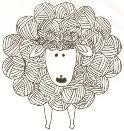Monday 28 January 2013
Pondering an holey question
I have wondering why so many shawl patterns use garter stitch? As I have spent much of the last week in bed (see earlier post) and not really having the inclination to do anything that required too much thought or exercise I have been idly surfing the web on my new Samsung Tablet at the same time trying to become familiar with what all the little icons do! Mostly I have been trawling through the patterns on Ravelry - especially patterns of shawls. I have always associated shawls with light airy knitting, full of yarn overs and knit two togethers, work with fine lightweight (lace) yarn on a slightly larger needle. While there are lots of patterns that fit that criteria, there are many more that don't!
So what is a shawl? The dictionary defines shawls thus:
Shawls (plural of Shawl) Noun 'A piece of fabric worn by women over the shoulders or head or wrapped around a baby'. But then there is the Tallith/Tallis which is a shawl worn by male Jews, with a ritually knotted fringe at each of four corners, worn at morning prayers.
Historically the shawl is a square, folded into a triangle, or a triangle shaped woven cloth worn mainly by women around the shoulders for warmth and also to cover the head. Evidence suggests that shawls in this form have been worn for millenia, with denser fabric being used in the colder regions and lighter more flimsy fabrics in warmer climes. Shawl brooches and pins are common finds on archaeological digs in this country from Viking women.
When it comes to knitted shawls a well known free encyclopedia defines the shawl (which by the way comes from the Persian Shal) as triangular shaped garment usually knitted from the neck down with or without shaping. Another defination stated that each shawl consists of two triangular side panels, a trapezoid-shaped back gusset, an edge treatment, and usually shoulder shaping, worn over the shoulders - nothing about lacy patterns. I did come across a wonderful blog post on the subject of shawls which seemed to confirm that shawls were not historically light or lacy.
So historically it seems that the shawl was a practical item of clothing, more often than not woven in wool for warmth. The modern shawl it seems became popular as a fashion item with the introduction of the pashmina from India in the 1770s. The paisley (name partly for the pattern and also the place in Scotland where such shawls were manufctured) shawl, was woven using a traditional motif from Kashmir the stylised cone-shaped motif known as the boteh, was popular in the early 19th century.
Google shawls and you get images of the paisley shawl and similar, do the same with knitted shawls and you get pictures that include the delicate lacey shawls of my dreams, but also many that obviously are knit in garter stitch.
So I have come full circle - what constitutes a shawl? It seems that any knitted, crochet or woven fabric constructed in way that ensures it can be worn over the shoulders is a shawl. So it seems that I must accept that garter stitch shawls are as 'correct' as lacey shawls and not get bogged down with too many yarn overs! But garter stitch is sooooooooooooo boring , but because it is sooooooooooo easy to pick up a stitch from the row below the one you're knitting you can't relax at all!!
Who knows I may one day finished that striped garter stitched shawl that I started on January 1st 2013, but I wouldn't hold my breath.................
Subscribe to:
Post Comments (Atom)








No comments:
Post a Comment
Note: only a member of this blog may post a comment.